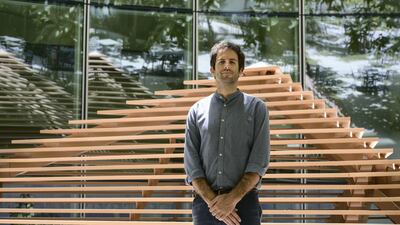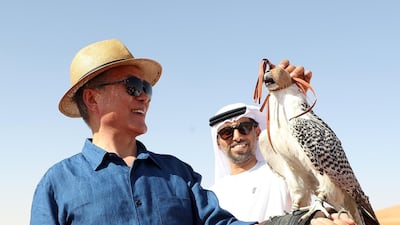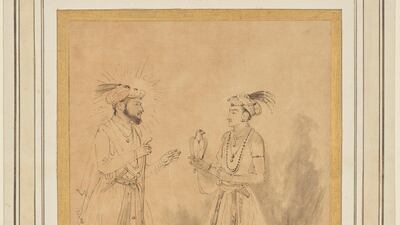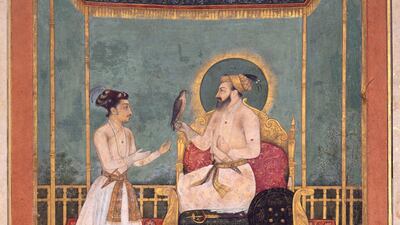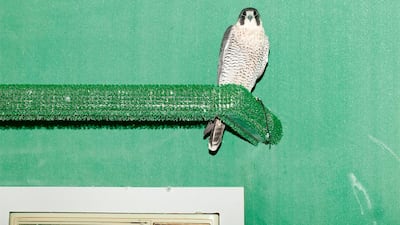The art historian Yannis Hadjinicolaou, a humanities research fellow at New York University Abu Dhabi, is investigating how the falcon has become synonymous with wealth and power, whether in glossy advertising campaigns or as a gift between state leaders.
The early days
Falconry has been a global practice for centuries: from the Moghul empire to Bedouin hunters to the courts of medieval Europe. In all these traditions, the falcon has signalled might, surfacing in different kinds of images to bestow power upon the person who holds it. Hadjinicolaou shows how falconry’s association with power results as much from the practice of falconry as from the images that depict it.
“A history of falconry is not conceivable without the images,” he says. The golden age of falconry was in the 15th century, when oil paintings in Europe and miniatures on the Indian subcontinent regularly depicted sovereigns hunting – or simply posing – with falcons. Hunting was then part of the expected comportment of any decent ruler.
“It had a political meaning as a model of how to handle the state,” Hadjinicolaou explains. “We have many paintings of children – for example, Maximilian the First [the first Holy Roman Emperor], holding in his hand a falcon’s hood. He shows that already as a child he can handle falconry, and hence, ruling. The point is that the falcon remains wild. It can never be domesticated. A true falconer knows that, and can adapt.”
Sovereigns visiting other courts would bring retinues of falcons as gifts. It was a means of "acknowledging the other ruler's power," Hadjinicolaou says, while at the same time hinting at competition. After the exchange of gifts, rulers would ride out to hunt together.
Falconry in the UAE
Although European leaders rarely go falcon hunting today the practice of giving falcons as gifts is still current, particularly in the UAE, where it is part of the Bedouin heritage and is a common upper-class activity. South Korean president Moon Jae-in posed gamely in the Abu Dhabi desert with a bird on his hand on a recent visit, and King Hamad bin Isa Al Khalifa of Bahrain and Abu Dhabi Crown Prince Sheikh Mohammed bin Zayed enjoyed falconry in the desert during the Bahrain sovereign's visit in February.
Artist Raja’a Khalid, who grew up in Dubai, is studying falconry in the UAE for its connection to class and gender, in a separate research project. “Since the concept of citizenry in the Gulf and the modern day Emirates is so closely entwined with class, it makes the practice of falconry doubly interesting,” she says. “Falconry isn’t a typically aspirational activity. The everyday person who is a non-citizen residing in the country doesn’t necessarily aspire to take up falconry. The fact that it is also such a gendered activity and that there is no internationally recognised certification for falconry and hawking in the UAE means that the knowledge behind the practice is quite often passed down from father to son, making it quite a closed and exclusive activity.”
Khalid has made a sculpture of a falcon in fluorescent yellow that underscores how falcons exist not simply as birds, but as emblems.
"The colour (neon yellow) and material (acrylic) were chosen to highlight the falcon's trophyness, its mythology, its replaceability with just about any other contemporary motif of wealth in the Gulf," she says. "It's a sport that allows the owner to confer some physical prowess directly to the bird."
Hadjinicolaou has found historical instances of the same phenomenon. In the 1700s, the sporting gun began to edge out birds as the weapon of choice in courtly hunts. Paintings from that period duly include guns next to the prey – but continue to picture falconry accoutrements as well, such as the hood or lure, even if they hadn't been used. The falcon appears by proxy simply to signify status.
“The images of falconry are produced in huge numbers, but not anymore for those who hunt,” Hadjinicolaou says. “The weapon overtakes, but the images do not decline.” Bourgeois children are depicted holding falcons, no longer to show their capacity to govern, but rather the idea “that they can someday rule their parents’ business or economic affairs”.
'Once you look for them, they're everywhere'
Hadjinicolaou also underlines how images of falconry were part of cross-cultural exchange. “Falcons are image vehicles,” he says. “In the truest sense of the word: they move around.” A current exhibition at the J. Paul Getty Museum in Los Angeles, for example, shows how Rembrandt was influenced by Mughal watercolours of rulers, which arrived in Amsterdam along with other goods from the Dutch East India Company’s burgeoning trade with Asia. He copied these images of falcon-giving in his looser style of brushwork, passing the historical Indian practice on to 17th-century Holland.
Rembrandt is an unlikely entree into the world of falconry, but he’s proof of the surprising ubiquity of the bird. “Once you look for them,” Hadjinicolaou says, “they’re everywhere!”
________________
Read more:
Falconry Research Project: database by UAE researchers shows ubiquity of predatory bird
On the hunt with falconers in Abu Dhabi
Emirati woman's passion for falconry takes flight
Falcons the ultimate symbols of pride and unity for Emiratis
________________
The Dutch painter was also part of Hadjinicolaou's dissertation from Humboldt University of Berlin, which looked at followers of Rembrandt who resisted then-fashionable French-style painting.
Though Greek by origin, Hadjinicolaou was born in Paris in 1983 to academics. His father was an art historian and his mother a historian of Mediterranean studies. He knew by the age of 16, he says, laughing, that he wanted to learn Dutch and study Netherlandish painting – a kind of high-brow rebellion against his father, an El Greco expert whose area of specialty was France and the south of Europe.
“The German tradition of art history is more akin to the English idea of visual culture,” he explains, “in which art history is not a succession of masterpieces, but a visual lexicon” comprised of all kinds of images, from illustrations to etchings to 100 dirham notes, that create society and human behaviour as much as reflect it.
“Images are not mere illustration of historical fact,” he finishes. “It is actually the other way around. They have an impact on ourselves and our thoughts.”
